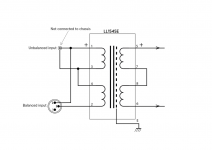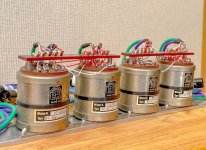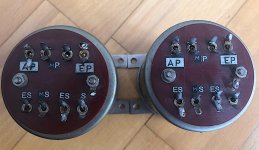If that is an E5-M then there are 2 input (Primary) windings and just 1 output winding (Secondary). Let me redraw, just a moment.
This was an example of "original lettering".
I wrote that somebody modified the original letters
and suspect the wiring has been changed also.
Perhaps the top plate is reversed.
I wrote that somebody modified the original letters
and suspect the wiring has been changed also.
Perhaps the top plate is reversed.
Im trying options and well, yes its possible to change the behaviour and the sound quality. But in the option A, wich seems to be the simple one, there is only about 1-2 dbs more and it sounds cleaner and wider. Other options are darker as the transformer becomes more noticiable. But in option A, is very pleasent because the transformer do something beautiful and is more airy, wider, more space between frecuencies... It seems like when pushes it changes some high frequencies.
This drawing is more realistic. Yes of course things change when you play around with the windings as the circuit will be a different load to the source in terms of impedance/transformation ratio/gain. That is what a transformer does, you will need to use and adapt parameters to the most optimal situation technically. One can not judge and try out by listening only. That is not how things work.
Think of a 115/230V to 2 x 12V toroid. If you live in Spain you will use the 115V windings in series for 230V AC. You will connect the 12V windings in series for 24V output or you will wire the 12V windings in parallel for 12V output at double the possible current. Using the primary 115V windings in parallel on 230V mains voltage will work as well but for a very short time. Then the output voltages will not be as wanted 🙂
Think of a 115/230V to 2 x 12V toroid. If you live in Spain you will use the 115V windings in series for 230V AC. You will connect the 12V windings in series for 24V output or you will wire the 12V windings in parallel for 12V output at double the possible current. Using the primary 115V windings in parallel on 230V mains voltage will work as well but for a very short time. Then the output voltages will not be as wanted 🙂
Attachments
Last edited:
Great, yes, the best option is to do something to have it open to be changed easily because every mix will work better with a different behaviour. So helpful. thanks.
There is quite some technical information and knowledge needed to use signal transformers optimally. They provide galvanic separation and can "amplify" signal or transform it to lower level. All this at a cost... input/output impedances will change too and a chosen configuration must be driven by a circuit too. Maybe the chosen configuration can not be driven by the source....then the source needs to be changed. The "load' at the secondary side will also be of influence. Just think of loading it with 10 Mohm or 10 Ohm....and what will happen at the source side. I dare to state that transformers are the most complex devices in electro/electronics and I still learn every day as they are complex devices despite their apparent simplicity.
Please think how you can use the input windings.... when used "in phase".....
1. just 1 winding
2. both windings in series
3. both windings in parallel
Now think in terms of transformation ratio ("gain")/impedances and what the differences may be also for the driving source. The source may drive one of the possibilities with ease while suffering to do so with the other.
You can of course just try out all scenarios but this is then an exercise as often found in the tube section ("I just do something"). Normally one defines and chooses a device for a certain task. In this case there are 2 transformers and a few possibilities so what is wanted and needed? What is the circuit? What is the task? What are the signal levels? Then the transformers should be wired to cater for that operation and both source and following circuits should be able or even adapted. That is the beautiful but sometimes also a bit ugly reality.
Please think how you can use the input windings.... when used "in phase".....
1. just 1 winding
2. both windings in series
3. both windings in parallel
Now think in terms of transformation ratio ("gain")/impedances and what the differences may be also for the driving source. The source may drive one of the possibilities with ease while suffering to do so with the other.
You can of course just try out all scenarios but this is then an exercise as often found in the tube section ("I just do something"). Normally one defines and chooses a device for a certain task. In this case there are 2 transformers and a few possibilities so what is wanted and needed? What is the circuit? What is the task? What are the signal levels? Then the transformers should be wired to cater for that operation and both source and following circuits should be able or even adapted. That is the beautiful but sometimes also a bit ugly reality.
Last edited:
Hi friends, im asking for help to connect two Malotki transformers to XLR in and out connectors to pass sound though them as a stereo pair.
I attached the schematic of a Lundahl circuit to achieve what you want (missed that in the heat of the battle because of lacking/confusing data and also with theory, sorry). In your case there will only be one secondary winding so the AS and ES connections going to pins 2 and 3 of the XLR output connectors. If I am right then you will have a 0.7:1 ratio when used like this and I don't know if that is what you really want as signal levels are predefined and often high enough in the balanced world. A 1:1 ratio would seem better in that aspect. Still the lack of a datasheet of E5-M (not helped by the relabelling 😀) is what is making matters too complex and thus dependent on assumptions and educated guessing.
You can translate the schematic in post #44 to the Lundahl one.
Attachments
Last edited:
The picture of post 27 would have been useful to see from the beginning to prevent endless speculation.
> you will have a 0.7:1 ratio
That confirms what I did not want to speculate. The *pair* of 0,7:1 transformers is used to convert stereo program from L+R to M+S or M+S to L+R. There is no other excuse for making these things. They still have some small demand for that purpose: some record mastering operations work better in M+S mode, although increasing digital is putting M+S transformers out of work.
Any other use, such as L+R to L+R, is not what the designer intended. Since they are very low impedance (200? 600?) they won't have major flaws however you wire them, unless you try to drive straight from tubes. They should not distort at in-house levels. (The HIGH levels used for long-line national networks might smudge the deep bass.)
They were not made to (galvanic) isolate grounds. They will, far-far better than an RCA jack, but are not intended for that the way the big WE line irons were.
And yes, stop soldering on them!!! This isn't rough carpentry.
Last edited:
No one is soldering so there is no need to say that. thanks for your info.
Yes they were used in a mid side configuration so that is why someone changed the letters on them.
Anyway they work perfect in my stereo setup, they are very transparent but what they do is really useful for me.
thanks.
Yes they were used in a mid side configuration so that is why someone changed the letters on them.
Anyway they work perfect in my stereo setup, they are very transparent but what they do is really useful for me.
thanks.
Attachments
Post 48 : this is true and the transformers are very sought after in some parts of the recording scene.
I only have two, and they are not the ones that i showed in the last picture. That was from a friend´s studio. Anyway is the first time that i see a pair with that change.
yes they are the same, see this pic. My last question is about the ratio wich i have never seen other Malotki transformer with this ratio 0,7 : 1.
They usually are 1: 1.
Does the 0,7 mean that it lows the signal at first?.
thanks.
They usually are 1: 1.
Does the 0,7 mean that it lows the signal at first?.
thanks.
Attachments
yes exactly, that is not solder, please read again my 49 post and anyway i dident like the way you expressed that to me, there is no need for that, so please dont write again to me. Thanks for your info.
Hi I tried to help out but I have no knowledge at all of M+S stuff so glad that PRR came to help. Still I get the impression that the transformers are totally redundant in a balanced setup compared to not using them at all 🙂 What is it exactly what you expect of them?
Especially as they are 0.7:1 which will make the situation non standard and the improvement seems trivial.
Especially as they are 0.7:1 which will make the situation non standard and the improvement seems trivial.
Last edited:
Hi Jeal Paul, I aprecciate all your help so much. This is what i wanted to find out because this transformers are being used in many studios for some reasons that are subjective. Some people find that it gives colour or it warms the sound, also it gives some saturation to the low end or even creates a wider stereo image. Now that i have them to me they are very transparent but they really do all that. I have them after my digital to analogue converters and they help to sound less digital. Is not a big change but its there and i like more and more every time i listen to it. Also there is a very subtle compression in the signal without the usual signs of a compressor wich is really useful. Thanks to you all.
- Home
- Source & Line
- Analog Line Level
- Help to connect MALOTKI transfomers.



